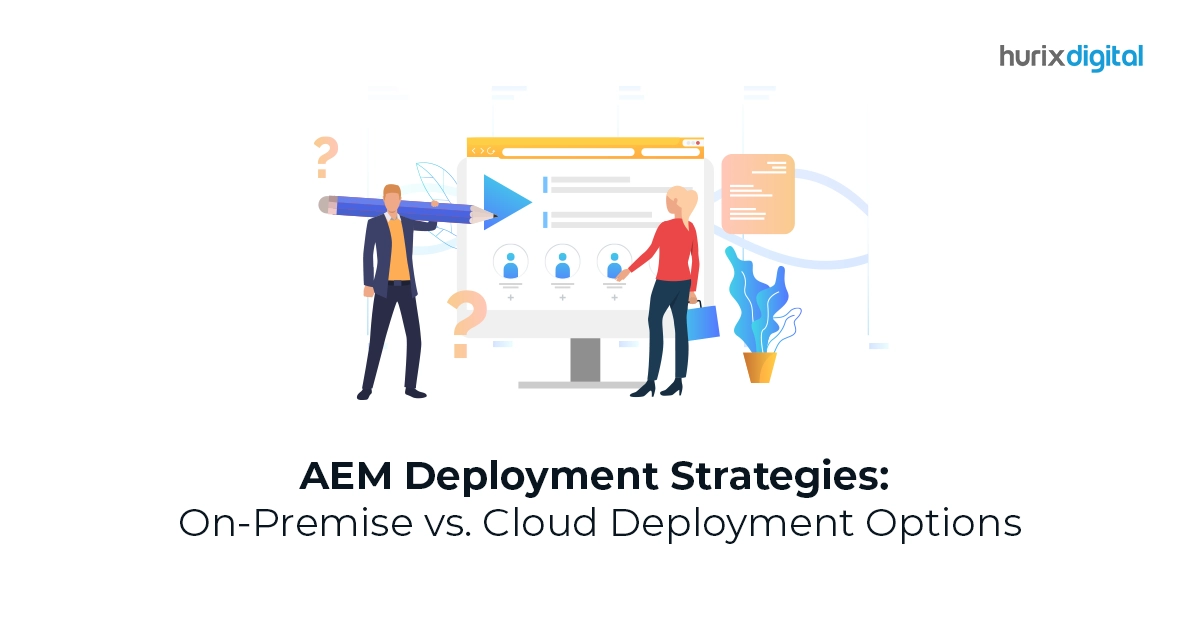
AEM Deployment Strategies: On-Premise vs. Cloud Deployment Options
Summarize with:
In this dynamic landscape of digital experience management, achieving success requires the right Adobe Experience Manager (AEM) implementation strategy. AEM, a robust content management solution, offers two primary deployment avenues: On-premise and Cloud. Both have different roles and impacts and choosing the right strategy can make or break the digital experience.
While each strategy has its advantages, disadvantages, and critical considerations, choosing the one that can influence the decision-making process is crucial. Understanding the importance of On-Premise vs. Cloud Deployment strategies within Adobe Experience Manager (AEM) not only helps in shaping the control of an organization’s infrastructure, but it can also impact scalability, cost, and overall efficiency.
This article explores Adobe Experience Manager (AEM) and its strategies for making informed decisions about aligning technology with business objectives. The performance comparison between the two can help in better decision-making.
Table of Contents:
- Key Considerations for AEM Implementation
- Explaining On-Premise Deployment in AEM
- Explaining Cloud Deployment in AEM
- Comparison Between AEM Deployment Strategies: On-Premise vs. Cloud Deployment
- Best Practices for AEM Deployment
- Wrapping Up
Key Considerations for AEM Implementation
Carefully navigating the Adobe Experience Manager (AEM) implementation decision requires weighing several factors. Such considerations are important, especially for ensuring the effectiveness of the chosen strategies.
Here are some key points to consider:
- Evaluate current and future scalability requirements and ensure the chosen solution can facilitate growth.
- Alight the deployment strategy with overarching business objectives and goals.
- Evaluate financial limitations, focusing on upfront costs and long-term expenses.
- Maintain a balance between the desire for control over infrastructure (on-premise) and the flexibility offered by cloud solutions.
- Estimate the sensitivity of data and regulatory compliance, addressing security concerns associated with the chosen deployment method.
Also Read: AEM Migration 101: Everything You Need to Know to Transition to AEM Platform Successfully
Explaining On-Premise Deployment in AEM
Adobe Experience Manager (AEM) on-premise deployment involves hosting within the data centers of the organization. It offers a high degree of control over the entire infrastructure, estimating direct management of hardware and software.
Here are some major advantages of AEM’s on-premise deployment:
- Control and Customization: Organizations have detailed control, allowing for customization based on specific requirements and security protocols.
- Data Security: AEM’s on-premise solutions allow organizations to enjoy a heightened sense of data security, especially those dealing with sensitive information.
- Potential Challenges: Besides advantages, some challenges may arise in terms of scalability. Especially since expanding resources may demand considerable time and investment, particularly in obtaining and configuring additional hardware, adding to the overall maintenance considerations.
Explaining Cloud Deployment in AEM
Cloud Deployment, on the other hand, transfers AEM to third-party cloud infrastructure, such as AWS, Azure, or GCP. This unique approach focuses on flexibility and scalability, along with cost efficiency.
Here are some of the significant characteristics of AEM Cloud Deployment:
- Flexibility and Scalability: AEM’s cloud deployments offer unparalleled flexibility, particularly beneficial for dynamic workloads. This strategy allows organizations to scale resources up or down swiftly based on demand.
- Cost-Efficiency: Within cloud deployment, the pay-as-you-go model can effectively reduce upfront costs, making it an attractive option for organizations seeking a more economical approach.
- Dependency on Service Providers: However, besides the said advantages, the reliance on external service providers means organizations may have to surrender some control over the underlying infrastructure.
Comparison Between AEM Deployment Strategies: On-Premise vs. Cloud Deployment
Uncover the comparison between AEM’s On-Premise and Cloud Deployment strategies via scalability, cost considerations, and security implications. Here are some insights for effective decision-making:
1. Comparing Scalability
In considering AEM deployment, scalability differentiates between on-premise and cloud implementations. On-premise may involve resource constraints, while cloud solutions showcase adaptability, enhancing overall AEM implementation agility.
In AEM’s on-premise scenarios, scalability usually involves two basics: procuring and configuring additional hardware. It may further lead to time and resource constraints.
Whereas in AEM’s cloud deployments, the ease of swift scalability allows organizations to adjust resources effectively given the fluctuation of workloads. In short, adaptability is a hallmark of cloud solutions (in terms of scalability), which enhances overall agility and responsiveness.
2. Cost Consideration
When choosing between on-premise and cloud deployments, cost analysis can be a deciding factor. On-premise solutions are usually the ones with higher upfront costs, focusing on software, hardware, and maintenance.
Whereas, cloud deployment solutions reduce the initial experience given that organizations follow a pay-as-you-go model.
However, not all organizations must examine long-term costs, as regular cloud usage may exceed on-premise expenses over time. Particularly, factors like storage, service subscriptions, data transfers, and more may increase the overall cost equation.
Therefore, organizations need to understand both immediate and long-term financial commitments before choosing between the two.
3. Security Implications
On-premise and cloud deployments require observant attention in terms of security considerations. The on-premise solutions do offer a higher degree of direct control over security measures. This strategy also allows organizations to implement customized protocols.
Robust security measures from service providers back cloud deployments, and therefore, concern about data accessibility may arise. In terms of this strategy, cloud deployments must focus on certain grounds, including encryption, identity management, and compliance adherence.
It is crucial to maintain clear communication with cloud providers and thus use the safest practices in access control to mitigate security risks.
Best Practices for AEM Deployment
To deploy Adobe Experience Manager (AEM) implementation efficiently, organizations must stick to essential best practices across various areas. Some of the best practices include the following:
- Scalability, Performance, and Disaster Recovery (Oak): Follow guidelines for optimal scalability, high performance, and robust disaster recovery features.
- Environment Configuration: Use separate environments for authoring and publishing to prevent accidental content changes on the production instance.
- Backup and Restore: Regularly back up your AEM instances, including both content and repository data, and practice restoring these backups to ensure they are working correctly.
- Content Scalability and Management: As content is at the heart of AEM, managing it effectively is essential. You should plan for content scalability from the start, implementing a logical content structure, utilizing DAM (Digital Asset Management) effectively, and applying best practices for tagging and metadata management.
- Content Deployment: Use packages or replication agents to deploy content between environments, ensuring consistency and integrity.
- Code Deployment: Use a version control system (VCS) to manage AEM code, and use build tools like Maven to automate the deployment process.
- Configuration Management: Use configuration management tools to manage configurations across environments, ensuring consistency and avoiding configuration drift.
- Monitoring and Logging: Set up monitoring and logging to track the health and performance of your AEM instances, helping you identify and resolve issues quickly.
- Security Best Practices: Security is paramount in any digital deployment. Follow security best practices, such as using HTTPS for all traffic, implementing strong authentication and authorization mechanisms, and regularly applying security patches. Adherence to secure coding practices and user access management is also crucial.
- Performance Optimization: Optimize your AEM deployment for performance by following Adobe’s performance tuning guidelines and regularly reviewing and optimizing your configurations. It includes optimizing page load times, implementing caching strategies, and monitoring system health.
- Content Delivery Network (CDN): Use a CDN, such as Akamai Edge Delivery or Amazon Cloud Front, to cache and deliver static assets, reducing load on your AEM instances and improving performance for end users.
- AEM Communities and Support: Engaging with the AEM community and utilizing Adobe support resources can provide valuable insights and assistance. Whether it’s through forums, documentation, or direct support, leveraging these resources can help overcome challenges and stay informed on best practices and new features.
- Testing and QA: Implement thorough testing and quality assurance processes to catch issues early and ensure a stable deployment.
Check out EXCLUSIVE: Hurix Mini-Book: Mastering AEM & Platform Services – A Comprehensive Guide
Wrapping Up
Overall, choosing between AEM’s on-premise and cloud deployment strategies demands a careful balancing act. AEM’s on-premise strategy offers control but requires meticulous scalability planning. Whereas its cloud deployment solutions are flexible and cost-saving but balance the sacrifice of some control. When choosing amongst these two, prioritize what you need—control, scalability, and cost—and enjoy best practices.
You can also contact Hurix Digital, your trusted AEM partner, and explore numerous possibilities for your business. With Hurix Digital, you gain access to expert guidance and support at every stage of your AEM journey. Our professionals will assist you at every stage to ensure your business reaches new heights with the most suitable AEM deployment strategies.
Contact Hurix Digital today! Our expert team is ready to assess your needs and guide you to success.
Summarize with:

Vice President & SBU Head –
Delivery at Hurix Technology, based in Mumbai. With extensive experience leading delivery and technology teams, he excels at scaling operations, optimizing workflows, and ensuring top-tier service quality. Ravi drives cross-functional collaboration to deliver robust digital learning solutions and client satisfaction
 Upcoming Masterclass | Build an Army of Brand Evangelists using Training & Development | November 20th, 8:30 AM PDT | 11:30 AM EDT | 10:00 PM IST
Upcoming Masterclass | Build an Army of Brand Evangelists using Training & Development | November 20th, 8:30 AM PDT | 11:30 AM EDT | 10:00 PM IST
